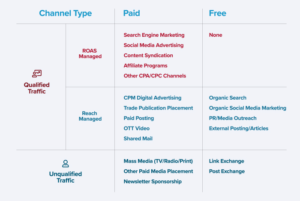This is post #6 in a 10-part series on the New B2B Marketing Paradigm.
In our last post, we discussed how to revamp your audience segmentation strategy to account for customer intent. In this post, we’ll talk about how to use your new and improved segmentation strategy to drive a consistent flow of traffic to your site.
What is Demand Gen, Really? And How Does Awareness Fit In?
Demand generation is the art of creating a genuine desire for your product. Within the B2B realm, this requires: 1) building awareness of your company, 2) educating the market on your product, and 3) ultimately delivering qualified leads to your sales teams.
Building awareness is the hardest and costliest part of this equation, and it all starts with your target audience. Remember how, in your customer segmentation model, you ranked a prospect’s strategic fit based on firmographics like their industry and company size? For the purposes of the chart below, we are going to consider qualified traffic any audiences where at least 50% are within your target market’s “strong” or “moderate” fit categories. Other audiences will be considered unqualified traffic.
Demand generation is the art of creating a genuine desire for your product. … Building awareness is the hardest and costliest part of this equation.
Reaching that qualified traffic is core to your awareness-building strategy, and you’ll want to turn to two different types of paid advertising to do it: 1) return on advertising spend (ROAS) and 2) reach. Note that both cost money. Ignoring time and labor, awareness building will be the most expensive portion of your marketing efforts. But if you’re strapped for cash, there are a few free alternatives out there, which are listed in the chart below.

ROAS vs. Reach: What’s the Difference? Which is Better?
The key difference between ROAS and reach advertising channels is how you pay for them. With ROAS, you’ll be charged for each action the prospect takes on your ad, whether that’s a click or a download or a free trial signup. With reach, you’re paying for pure views. Both channels are valuable and necessary for generating awareness. Here’s why.
Return on advertising spend (ROAS) managed channels, because they are so highly targeted, tend to bring in traffic that converts at a high rate. Think of someone who downloaded your white paper because they saw an ad when they were searching for your exact type of software. The prospects you collect from these channels will likely already fall into the “high value, high intent” section of your audience segmentation chart, and you’ll need to do less nurturing to turn them into qualified leads for sales.
Reach managed channels, on the other hand, will always require a nurturing program to turn traffic into qualified leads. Think of someone who clicks through your YouTube ad, for example. It is a rare occurrence indeed where you should send a lead from these sources directly into sales. But reach managed channels allow you to buy access to an audience that otherwise might never see your product.
Both [ROAS and reach] channels are valuable and necessary for generating awareness.
OK, But Why Would I Pay for Ads to Reach Unqualified Traffic?
Even groups with less than 50% of people in your target audience will still contain a few strong leads that you may not want to miss out on. Thus, a mass media approach (like an ad in the Wall Street Journal, for example) can be useful. Yes, you’ll be addressing a massive number of people for whom your ad is not relevant, but you’ll also be reaching some folks in your target audience. This is where the old adage, “I know that half of my advertising budget is wasted; I just don’t know which half” comes from. While not a replacement for targeted advertising efforts, mass media buys can provide a less expensive complement to your targeted campaigns. Use them to get your brand out there, and you may just reel in a few strong leads as a result.
Once you’ve checked all the boxes in the chart above and are successfully driving traffic to your site, the real work begins: nurturing your leads. The beauty of this part of the marketing effort is that it is mostly inexpensive and highly responsive. The difficult part is that it requires a lot of heavy lifting from your team, and they’ll need good data to make all that effort pay off.
More on that next time.
As always, reach out to continue the conversation:
